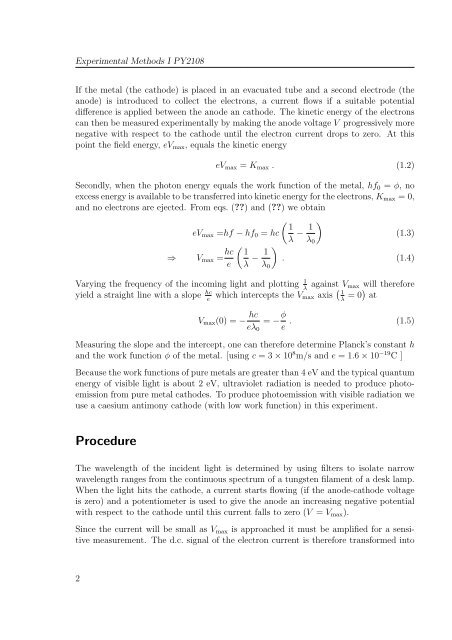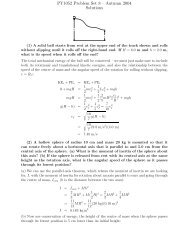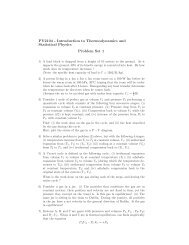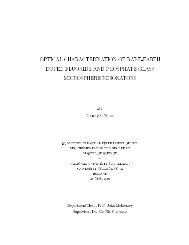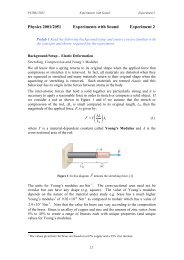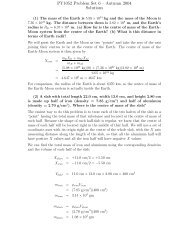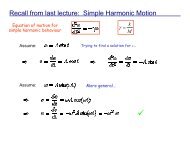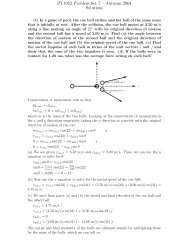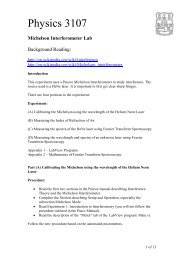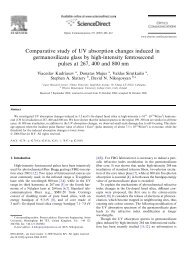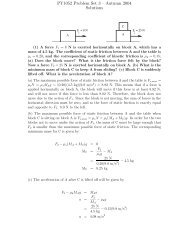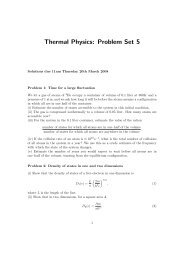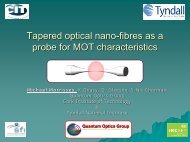1 The Photoelectric Effect - Measurement of the Planck constant
1 The Photoelectric Effect - Measurement of the Planck constant
1 The Photoelectric Effect - Measurement of the Planck constant
Create successful ePaper yourself
Turn your PDF publications into a flip-book with our unique Google optimized e-Paper software.
Experimental Methods I PY2108If <strong>the</strong> metal (<strong>the</strong> cathode) is placed in an evacuated tube and a second electrode (<strong>the</strong>anode) is introduced to collect <strong>the</strong> electrons, a current flows if a suitable potentialdifference is applied between <strong>the</strong> anode an cathode. <strong>The</strong> kinetic energy <strong>of</strong> <strong>the</strong> electronscan <strong>the</strong>n be measured experimentally by making <strong>the</strong> anode voltage V progressively morenegative with respect to <strong>the</strong> cathode until <strong>the</strong> electron current drops to zero. At thispoint <strong>the</strong> field energy, eV max , equals <strong>the</strong> kinetic energyeV max = K max . (1.2)Secondly, when <strong>the</strong> photon energy equals <strong>the</strong> work function <strong>of</strong> <strong>the</strong> metal, hf 0 = φ, noexcess energy is available to be transferred into kinetic energy for <strong>the</strong> electrons, K max = 0,and no electrons are ejected. From eqs. (??) and (??) we obtain( 1eV max =hf − hf 0 = hcλ − 1 )(1.3)λ 0⇒V max = hce( 1λ − 1 λ 0). (1.4)Varying <strong>the</strong> frequency <strong>of</strong> <strong>the</strong> incoming light and plotting 1 against V λ max will <strong>the</strong>reforeyield a straight line with a slope hc which intercepts <strong>the</strong> V e max axis ( 1= 0) atλV max (0) = − hceλ 0= − φ e . (1.5)Measuring <strong>the</strong> slope and <strong>the</strong> intercept, one can <strong>the</strong>refore determine <strong>Planck</strong>’s <strong>constant</strong> hand <strong>the</strong> work function φ <strong>of</strong> <strong>the</strong> metal. [using c = 3 × 10 8 m/s and e = 1.6 × 10 −19 C ]Because <strong>the</strong> work functions <strong>of</strong> pure metals are greater than 4 eV and <strong>the</strong> typical quantumenergy <strong>of</strong> visible light is about 2 eV, ultraviolet radiation is needed to produce photoemissionfrom pure metal cathodes. To produce photoemission with visible radiation weuse a caesium antimony cathode (with low work function) in this experiment.Procedure<strong>The</strong> wavelength <strong>of</strong> <strong>the</strong> incident light is determined by using filters to isolate narrowwavelength ranges from <strong>the</strong> continuous spectrum <strong>of</strong> a tungsten filament <strong>of</strong> a desk lamp.When <strong>the</strong> light hits <strong>the</strong> cathode, a current starts flowing (if <strong>the</strong> anode-cathode voltageis zero) and a potentiometer is used to give <strong>the</strong> anode an increasing negative potentialwith respect to <strong>the</strong> cathode until this current falls to zero (V = V max ).Since <strong>the</strong> current will be small as V max is approached it must be amplified for a sensitivemeasurement. <strong>The</strong> d.c. signal <strong>of</strong> <strong>the</strong> electron current is <strong>the</strong>refore transformed into2


